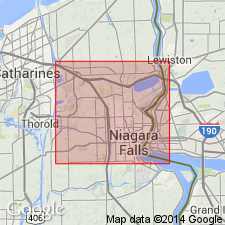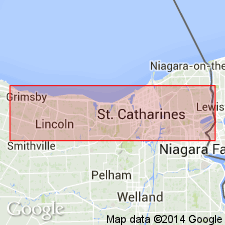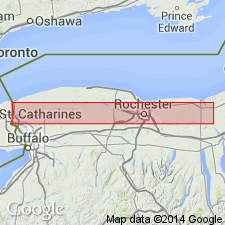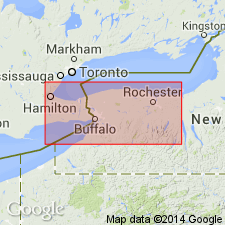
- Usage in publication:
-
- DeCew limestone
- Modifications:
-
- First used
- Dominant lithology:
-
- Limestone
- AAPG geologic province:
-
- Appalachian basin
Summary:
Name DeCew limestone proposed for basal member of Lockport dolomite. Overlies Rochester shale and underlies Gasport limestone. Unit is of Silurian age.
Source: GNU records (USGS DDS-6; Reston GNULEX).

- Usage in publication:
-
- DeCew limestone [bed]
- Modifications:
-
- Named
- Dominant lithology:
-
- Limestone
- AAPG geologic province:
-
- Appalachian basin
Summary:
Named the DeCew limestone for DeCew falls, Ontario, CAN. Consists of fine-grained, dark gray, argillaceous limestone, 2 to 9 ft thick. Basal bed of Lockport member of Niagara formation in Niagara Peninsula. Thickness is 2 to 9 ft. At some places weathered surfaces show cross-bedding and remarkable churned structure. The material of the beds suggests reworked Rochester shale to which lime has been added. Overlies Rochester member and underlies Gasport limestone [member].
Source: GNU records (USGS DDS-6; Reston GNULEX).

- Usage in publication:
-
- DeCew Formation
- Modifications:
-
- Revised
- AAPG geologic province:
-
- Appalachian basin
Summary:
An argillaceous, resistant limestone bed herein referred to as the Glenmark Bed overlies the Rochester Shale in the Sodus area of western NY. The Glenmark occurs at the base of the DeCew Formation according to the figure, and not within the Rochester as originally defined.
Source: GNU records (USGS DDS-6; Reston GNULEX).

- Usage in publication:
-
- DeCew Dolomite*
- Modifications:
-
- Overview
- AAPG geologic province:
-
- Appalachian basin
Summary:
The DeCew Dolomite, the uppermost formation of the Clinton Group, in western NY consists of variably bedded, dark-gray to olive-gray, argillaceous to sandy, fine-grained dolomite that locally contains shaly partings and interbeds. A middle bed of up to 3 ft thick is present in the southern Niagara River Gorge. Unit weathers to a distinctive light olive gray. Its most distinctive feature is soft-sediment deformation features that include flame structures and overturned and isoclinal folds. Thickness is 8 to 12 ft. Well exposed at Lockport Junction Road (Rte 429) west of Lockport, NY. Conformably overlies the Rochester Shale in most areas, but is unconformable at the southern end of the Niagara River Gorge; unconformably underlies the Gasport Dolomite. The DeCew is of Early Silurian (middle Wenlockian) age based on conodonts. [Report uses Early-Late Silurian boundary of Harland and others (1982) between the Wenlockian and the Ludlovian.]
Source: GNU records (USGS DDS-6; Reston GNULEX).
For more information, please contact Nancy Stamm, Geologic Names Committee Secretary.
Asterisk (*) indicates published by U.S. Geological Survey authors.
"No current usage" (†) implies that a name has been abandoned or has fallen into disuse. Former usage and, if known, replacement name given in parentheses ( ).
Slash (/) indicates name conflicts with nomenclatural guidelines (CSN, 1933; ACSN, 1961, 1970; NACSN, 1983, 2005, 2021). May be explained within brackets ([ ]).

